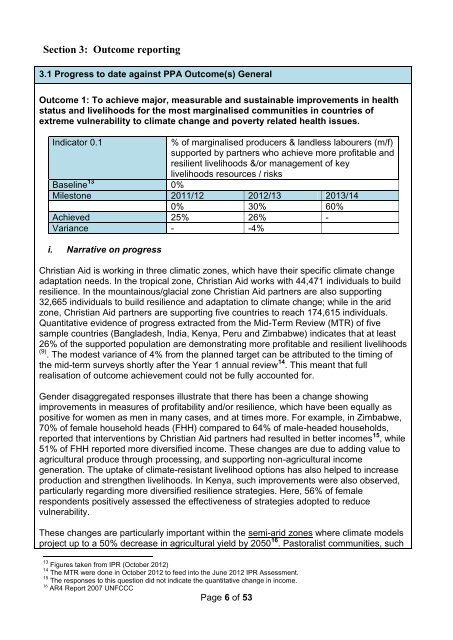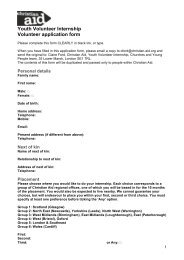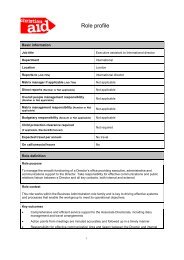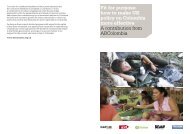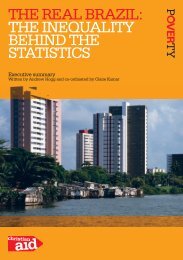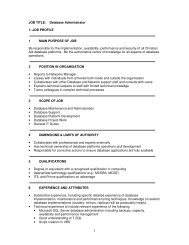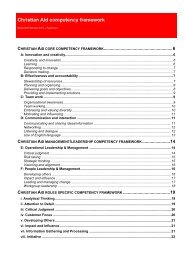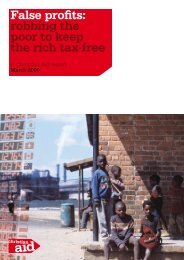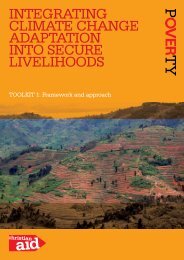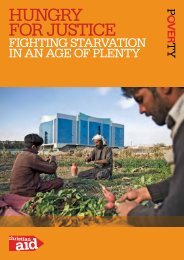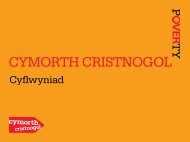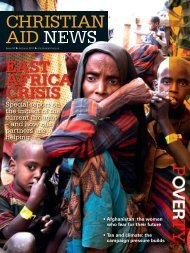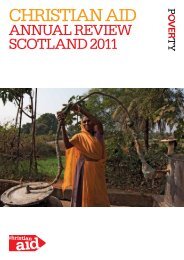DFID PPA annual report 2012-2013 - Christian Aid
DFID PPA annual report 2012-2013 - Christian Aid
DFID PPA annual report 2012-2013 - Christian Aid
You also want an ePaper? Increase the reach of your titles
YUMPU automatically turns print PDFs into web optimized ePapers that Google loves.
Section 3: Outcome <strong>report</strong>ing3.1 Progress to date against <strong>PPA</strong> Outcome(s) GeneralOutcome 1: To achieve major, measurable and sustainable improvements in healthstatus and livelihoods for the most marginalised communities in countries ofextreme vulnerability to climate change and poverty related health issues.Indicator 0.1% of marginalised producers & landless labourers (m/f)supported by partners who achieve more profitable andresilient livelihoods &/or management of keylivelihoods resources / risksBaseline 13 0%Milestone 2011/12 <strong>2012</strong>/13 <strong>2013</strong>/140% 30% 60%Achieved 25% 26% -Variance - -4%i. Narrative on progress<strong>Christian</strong> <strong>Aid</strong> is working in three climatic zones, which have their specific climate changeadaptation needs. In the tropical zone, <strong>Christian</strong> <strong>Aid</strong> works with 44,471 individuals to buildresilience. In the mountainous/glacial zone <strong>Christian</strong> <strong>Aid</strong> partners are also supporting32,665 individuals to build resilience and adaptation to climate change; while in the aridzone, <strong>Christian</strong> <strong>Aid</strong> partners are supporting five countries to reach 174,615 individuals.Quantitative evidence of progress extracted from the Mid-Term Review (MTR) of fivesample countries (Bangladesh, India, Kenya, Peru and Zimbabwe) indicates that at least26% of the supported population are demonstrating more profitable and resilient livelihoods(9) . The modest variance of 4% from the planned target can be attributed to the timing ofthe mid-term surveys shortly after the Year 1 <strong>annual</strong> review 14 . This meant that fullrealisation of outcome achievement could not be fully accounted for.Gender disaggregated responses illustrate that there has been a change showingimprovements in measures of profitability and/or resilience, which have been equally aspositive for women as men in many cases, and at times more. For example, in Zimbabwe,70% of female household heads (FHH) compared to 64% of male-headed households,<strong>report</strong>ed that interventions by <strong>Christian</strong> <strong>Aid</strong> partners had resulted in better incomes 15 , while51% of FHH <strong>report</strong>ed more diversified income. These changes are due to adding value toagricultural produce through processing, and supporting non-agricultural incomegeneration. The uptake of climate-resistant livelihood options has also helped to increaseproduction and strengthen livelihoods. In Kenya, such improvements were also observed,particularly regarding more diversified resilience strategies. Here, 56% of femalerespondents positively assessed the effectiveness of strategies adopted to reducevulnerability.These changes are particularly important within the semi-arid zones where climate modelsproject up to a 50% decrease in agricultural yield by 2050 16 . Pastoralist communities, such13 Figures taken from IPR (October <strong>2012</strong>)14 The MTR were done in October <strong>2012</strong> to feed into the June <strong>2012</strong> IPR Assessment.15 The responses to this question did not indicate the quantitative change in income.16 AR4 Report 2007 UNFCCCPage 6 of 53


